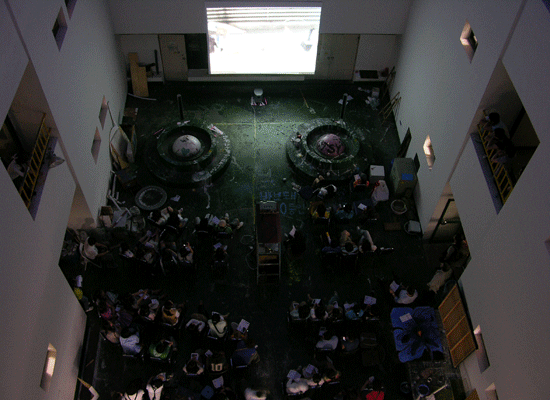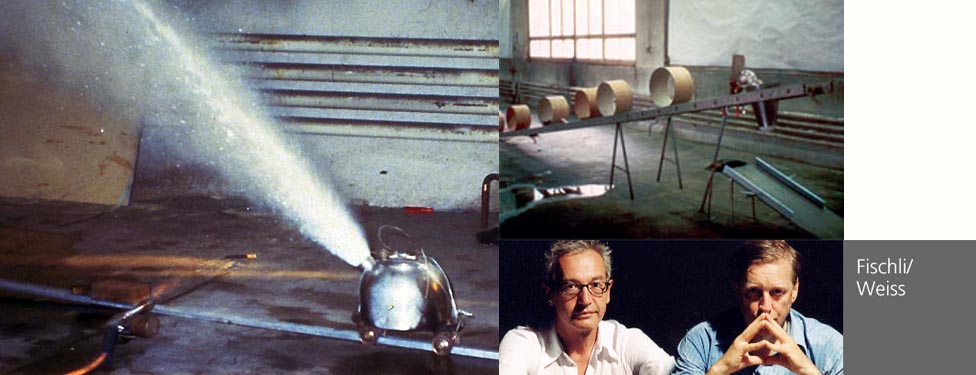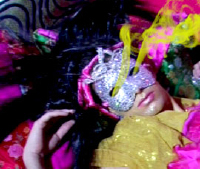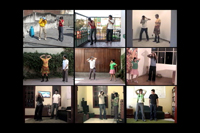

THURSDAY
• June 7 • 2007 • 7:30 PM
PROGRAM
02: NEW YORK CITY (part 2)
SPECIAL. A LEGENDARY ARTISTS FILM:
Der Lauf der Dinge (The Way Things Go) | Fischli/ Weiss | Switzerland
1987 | 30 min

A film about a precisely calculated chain reaction
Inside a warehouse, a precarious 70-100 feet long structure has been constructed
using various items. When this is set in motion, a chain reaction ensues.
Fire, water, law of gravity as well as chemistry determine the life-cycle
of objects - of things. It brings about a story concerning cause and effect,
mechanism and art, improbability and precision.
FISCHLI / WEISS (US/CH) is a world famous duo of conceptual artists
Black Pyramid | Bec Stupac | 2006 | 3:00 min.

Bec Stupak is an artist living and working in New York City, and
is also the founding member of Honeygun Labs, an experimental video project
that after a few years blossomed into a collaborative effort that at any
given time had several people creating and experimenting with different
styles and techniques.
Learning Stalls: Lesson Plans | Torsten Zenas Burns and Darrin Martin | 2005 | 6:00 min.

Learning Stalls: Lesson
Plans
Strange science: spoon-bending, psychic surgery, object formation, image
synthesis.
Torsten Zenas Burns and Darrin Martin began their collaborations in the
video and sculpture programs at the School of Art and Design at Alfred
University, where they both received their BFAs, 1990 and 1992 respectively.
Burns was born in 1968 and received his an MFA in video and performance
from the San Francisco Art Institute in 1993. Martin was born in 1969
and received an MFA in media and sculpture from The University of California,
San Diego in 2000. Together, they have based their single channel videotapes,
curations and current performance works on their research into diverse
speculative fictions including reimagined educational practices, cryptozoological
musical productions, and transhumanist sexuality recontructions. They
have jointly participated in a residency at Eyebeam in New York City.
In 2003, Electronic Arts Intermix commissioned their net art project,
which can be found at www.eai.org/lessons.
Selected videotapes are distributed by VTAPE, Canada; Recontres Internationale,
France; and Video Data Bank, USA. Videotapes have screened at venues including
The Museum of Art and Design (NY), Scanners: The New York Video Festival,
The New York Underground Film Festival, The Chicago Underground Film Festival,
Cinematexas, Pacific Film Archive (CA), Aurora Picture Show (TX), Madrid
Museum of Contemporary Art (Spain), Palm Beach Institute of Contemporary
Art (FL), Recontres Internationale, (Paris/Berlin), and the 50th Edition
of Oberhausen Short Film and Video Festival (Germany). They most recently
presented their work in Los Angeles at the University of Southern California’s
Transformations 3: Fiction Science conference.
Both artists also have exhibited and screened other collaborations and
solo projects extensively in a variety of national and international venues.
Burns is a visiting associate professor at KyungSung University in Pusan,
South Korea. Martin is an assistant professor at UC Davis.
MEET THE MAKER: Torsten Zenas Burns is Guest Prof at Kyungsung University and will be present at the screening!!!
Lo-Fi Green Sigh | Kristin Lucas | 2004 | 2:20 min.Lo-Fi Green Sigh | Kristin Lucas | 2004 | 2:20 min.
Kristin Lucas investigates visions of future from previous decades, the physical and psychological effects of an accumulation of rapid spread, flash-in-the-pan technology, and the impact of the digital medium on perceptions of time and space. Her video, performance, installation and internet works are distributed by EAI and Postmasters in New York. Lucas received her BFA from The Cooper Union in 1994 and her MFA from Stanford University in 2006.
Science’s Ten Most Beautiful Experiments: [#2 ) Galileo’s Experiment on Falling Objects | Jeanne Liotta | 2006 | 2:00 min.
The first real experimentalist was Galileo, who supposedly dropped a feather and a hammer simultaneously from the Leaning Tower of Pisa in order to prove by demonstration that the two would hit the ground at the same time. Approx. 400 years later that trick still works. (courtesy & sincerity, NASA 1971.)
Jeanne Liotta lives and works in New York City where she makes films and other ephemera. She also teaches widely and variously, including The New School , Pratt , The San Francisco Art Institute, and The Museum School in Boston and the Bard MFA program .Her latest project, Observando el Cielo' consists largely of 16mm field recordings of the night sky, and spans a constellation of mediums in an Emersonian framework at the intersection of art, science, and natural philosophy.
Blew Line | Ken Solomon | 2006 | 5:00 min.
The Blew Line video presents the process of photographing all of the red horizontal lines that I encountered over the course of a year. This daily obsession to gather data results in images of every day, universal mundane visual details united together by the “same” horizontal red line. It creates a harmony and relationship with totally unrelated elements- such as a snickers bar, with a Sol Lewitt painting with a row of kitchy bar stools.
Read My Lips | Stephanie Lempert | 2:00 min.

Read My Lips is a video piece which addresses the role of language as a method of communication. I worked with speech pathologist Beatrice Dulgarian to decipher the words being “spoken” by each fish. By using a speech pathologist to “read” the fish’s lips, I draw attention to the use of language and interpretation within our society.
Stephanie Lempert was born in Dallas, Texas. She received here B.F.A. from the Rhode Island School of Design. Her work exists in a wide variety of media including sculpture, photography and video. Her work has been exhibited domestically and internationally at places such as Socrates Sculpture Park, Weisspollack Gallery, The Moscow World Fine Art Fair, and The 2006 New York Video Festival. In April of 2007 the A.I.R. Gallery in New York will feature a solo show of her works.
Untitled (Three Revisited Fairytales) | Eileen Maxon | 2003 | 3:35 min.
Aurora picks more than berries, Lady gets a new reputation,
and Cinderella meets 90210.
Eileen Maxson drowns in white walls and cable television, emerging
on occasion to press record. Selected screenings and exhibitions include
the New York Underground Film Festival, New York. Cinematheque Ontario,
Toronto; Aurora Picture Show, Houston; Portland Documentary and Experimental
Film Festival, Portland, Oregon; The Dallas Museum of Art, and Cinematexas
International Film Festival. She is the recipient of grants from The Artadia
Award, The Dallas Museum of Art, the Cultural Arts Council of Houston/Harris
County, and the Austin Film Society.
Untitled (Rambo) | Rä die Martino | 2003 | 06:00 min.
Rä di Martino was born in Rome in 1975 and she lived in London since 1997 where she graduated with an MFA at the Slade School of Art. In 2004 she moved to New York with a research grant award at Columbia University.
Coin Toss | Matthew Garrison | 2006 | 3:46 min.
Coin Toss
connects a game of chance to ideas of fate and conflict by spinning silhouetted
coins against a red background of archival war footage. The color red
connects the imagery to violence and a state of emergency, while the choreographed
coins represent players navigating a violent past. The game also draws
attention to the polarization of conceptual and political issues within
a system of heads or tails. The emotional cost of war is acknowledged
in Coin Toss through wartime anonymity, intense color and the
use of essential forms.
Matthew Garrison is a professor of Digital Art at Hunter College,
NYC, and Albright College, Reading, PA. He received his MFA from Hunter
College and a BFA from the Rhode Island School of Design. Selected exhibitions
include the Roger Smith Lab Gallery in Manhattan, The University of Wisconsin’s
Foster Gallery and the Waterfront Center for the Arts in Belfast, Ireland.
The Frequency Of The Sun | Jason Boughton | 2005 | 10:00 min.
A gradual collage of Hollywood panorama, propaganda footage and combat reporting, The Frequency of the Sun plays a quotation game which is never fully resolved, tells a joke but the punch line is never entirely spoken. Performing a series of violent displacements of intention between mourning and celebration, the sky and the ground, Frequency is an exploration of the horizon line as the structuring element of American violence – an unreachable end-point, the boundless space which seems to verify a god-like power.
Boughton was born and raised in Washington State. He studied Literature and Studio Arts at The Evergreen State College. Now he lives in Brooklyn, NY, and is a MFA candidate in Visual Art at Columbia.
Temper Tantrum | John Richey | 2006 | 1:00 min.
A temper tantrum is an unplanned, unintentional expression
of anger, often with physical and verbal outbursts; it is not an act to
get attention, as is commonly thought. During a temper tantrum, children
typically cry, yell, and flail their arms and legs. Temper tantrums usually
last 30 seconds to 2 minutes and are most intense at the onset.
In Richey's characters, the outburst carries everything and nothing -
A universe of emotions and yet, nothing but a tiny glitch. (C.S.)
John Richey is a cross-disciplinary artist who creates intimate works about the paradoxical situations of fear and control. He received a BFA from The University of Arizona in 2001 and a MFA from the University of California, San Diego in 2004. His animations have been exhibited nationally and internationally and were mentioned in the “Best of 2004” issue of ARTFORUM International. Richey currently resides in Brooklyn, NY and is the Head Preparator at Greene Naftali Gallery.
Boxes, Jesus and Sandwiches | Jennifer Matotek | 2004 | 2:20
I found this bitchin’ doomsday cult recording
from the 1980s, and thought about the 80s, and the whole weird conservative
thing that was happening then, which is happening now… and then I thought,
“fuck it – let's throw some stuff together.”
Jennifer Matotek is an emerging curator, interdisciplinary artist, and
videomaker whose work has been shown across North America in galleries
and film and video festivals such as the Chicago Underground Film Festival,
the New York Underground Film Festival, and Cinematexas.
THURSDAY • June
14 2007 • 7:30 PM
PROGRAM
01: MEXICO CITY
Yepa Yepa Yepa | Miguel Calderón | 2002 | 4:23 min.
Miguel Calderón (Mexico City, 1971) is a video and installation artist whose work has been exhibited in Mexico and abroad, including at the Museo Rufino Tamayo, La Panadería and the Diego Rivera Gallery in Mexico, the San Francisco Art Institute and the Solomon R. Guggenheim Museum in New York. He both curates and writes about art. Calderón has a BFA from the San Francisco Art Institute.
VS [versus] | Demián Flores/Orlando Jiménez | 2005 | 8:00 min. (excerpt)
Starring Blue Panther, Hijo del Santo, VS is a conglomeration of short videos that originate from the evidencing of the sport-spectacle of “lucha libre”, its identity, theatricality, aesthetics, etc. The structure of these videos is based in repetition, in the multiple, the interminable, in a time-space game.
Microftalmia | Andrea Robles/Adriana Bravo | 2005 | 5:45 min.
Andrea Robles (Mexico City 1976) obtained a bachelor degree on Visual
Communication on 1999. In 2001 she formed the collaboration group dobleA
(doubleA) together with Adriana Bravo. In 2002 Robles she created Mirada
pérdida (Lost sight). The piece is an animation done with objects. She
conceives the work Anatomy of a Moth on 2004. During the same year she
received the stipendium Young Creators 2004-2005 from Arts and Culture
National Fund. Within this period Robles produces Microftalmía (Microphthalmia),
an experimental animation of oil drawings on glass.
Adriana Bravo. She was born on December 9th, 1972 in La Paz Bolivia. She
obtained a bachelor in Fine Arts with a major in painting. In 2000 she
moves to Mexico City to study an MFA at San Carlos Academy at the National
University
of Mexico. In 2002 she ventures into the moving image area with the animation
Lost Sight which marks the beginning of
her work in video and animation. In 2003 she creates the animation Anatomy
of a Moth. This work was shown at Video Brasil, Interfilm Berlin, Mex
Parismental Festival, Paris. It was also shown at the Antimatter festival
2005 in Victoria Canada. It was included in the section Foreign Matter:
Mexican Experimental Videos Latest Trends. In 2005 she produces Microftalmía,
an experimental animation of oil drawings on crystal.
Ciudad Moderna | Terence Gower | 2004 | 6:30
Terence Gower is a Canadian artist living and working between New York City and Mexico City. He works primarily with strategies of representation in modernist architecture, with a special focus on Mexican Modernism. He has exhibited his installations and videos in museums, galleries and public sites in Europe, Latin America, the US and Canada. His most recent book, Appendices, Illustrations & Notes was published by Smart Art Press, Los Angeles in 1999.
Parálisis | Gabriel Acevedo Velarde | 2005 | 2:15 min.
Gabriel Acevedo Velarde (Lima, Perú, 1976) works mainly in animation and video. After studying Fine Arts and working in film production in Mexico City, his work has been shown in different art spaces as well as video festivals, like in Museo Carrillo Gil (Mexico), Sala de Arte Público Siqueiros (SAPS, Mexico), Festival de Arte Electronica VideoBrasil (Sao Paulo), Galerie Adler (Frankfurt), National Museum of Contemporary Art (Bucarest), Centre pour l’Image Contemporain (Geneve), among others. Currently he lives in Sao Paulo and Mexico City.
Saida, Asra | Graciela Fuentes | 2006 | 3:20 min.
Born in 1975 in Monterrey, Mexico. Her practice includes installation, photograpy and video work that questions notions of geopolitics and cultural identities in the current global landscape. Fuentes recently completed the Whitney Independent Study Program. Her work has been presented in solo exhibitions in New York, Mexico, Portugal and Puerto Rico and in group shows in venues such as Stux Gallery, The Queens Museum, The Chelsea Art Museum, Smack Mellon, El Museo del Barrio, Exit Art,among others. She has received three grants from the National Council for Culture and the Arts in Mexico (CONACULTA) and was a 2005 Visual Arts Grant recipient from Fundación Marcelino Botín.
Escenario | Gabriel Acevedo Velarde | 2004 | 3:00 min.
This black & white animation depicts a group of little characters doing a strange and endless ritual in the middle of the mountains: one by one, they go up on a stage, where the shine of a strong spot light makes them pass over. After that, they recover among the audience, waiting for the next turn to climb back up to the stage.
Gabriel Acevedo Velarde (Lima, Perú, 1976) works mainly in animation and video. After studying Fine Arts and working in film production in Mexico City, his work has been shown in different art spaces as well as video festivals, like in Museo Carrillo Gil (Mexico), Sala de Arte Público Siqueiros (SAPS, Mexico), Festival de Arte Electronica VideoBrasil (Sao Paulo), Galerie Adler (Frankfurt), National Museum of Contemporary Art (Bucarest), Centre pour l’Image Contemporain (Geneve), among others. Currently he lives in Sao Paulo and Mexico City.
El Legado de Mc Gava | Paulina Lasa | 2003 | 5:44 min.

Paulina Lasa graduated from visual arts by the art departmen of UNAM in Mexico City. Her work has been shown individually and collectivelly in shows like: "Declaraciones", curated by Guillermo Santamarina at Reina Sofía, Madrid; "A place in time", curated by Claudia Arozqueta at Camp Street, San Antonio; "Free Trade", curated by Outpost for Contemporary Art in Los Angeles; "Dadapsicodeli", curated by Xavier Rodríguez at X-Teresa museum; "Pregúntale a Alicia", a site specific project at La Torre de los Vientos, Mexico City. Has been granted by the International Fund for the Promotion of Culture-UNESCO 2005, FONCA-CONACULTA 2005-2006, Fulbright-García Robles 2007-2009 and achieved the best documentary award by AluCine Film Festival 2006.
Crack, Line, Twig, Hole, Universe | Mauricio Alejo | 2002 - 2004 | 5:00
Mauricio Alejo. Fulbright Grant 2000 2002. Master in Arts for New York University 2000 2002. He has held solo shows in Mexico City, Toronto, Kyoto. Paris, and New York. His work has been featured at VIII La Havana Biennial and Paris Photo 2003, Triennal Poligrafica de San Juan de Puerto Rico among others international shows. Lives in México City and New York.
SPECIAL: SHORT DOCUMENTARY ON FAMOUS ARTISTS:
ART 21: Gabriel Orozco | PBS Series | 2002 | 25 minutes
Gabriel Orozco was born in Jalapa, Veracruz, Mexico in 1962 and studied at the Escuela Nacional de Arte Plasticas in Mexico City, and at the Circulo de Bellas Artes in Madrid, Spain. An avid traveler, Gabriel Orozco uses the urban landscape and the everyday objects found within it to twist conventional notions of reality and engage the imagination of the viewer. Orozco’s interest in complex geometry and mapping find expression in works like the patterned human skull of "Black Kites", the curvilinear logic of "Oval Billiard Table", and the extended playing field of the chessboard in "Horses Running Endlessly". He considers philosophical problems, such as the concept of infinity, and evokes them in humble moments, as in the photograph "Pinched Ball", which depicts a deflated soccer ball filled with water. Matching his passion for political engagement with the poetry of chance encounters, Orozco’s photographs, sculptures, and installations propose a distinctive model for the ways in which artists can affect the world with their work. Orozco was featured at Documenta XI (2002), where his sensuous terra-cotta works explored the elegance and logic of traditional ceramics—a pointed commentary on Mexican craft and its place in a ‘high art’ gallery space. Orozco has shown his work at distinguished venues including the Whitney Museum of American Art, the Museum of Modern Art, the Solomon R. Guggenheim Museum, the Philadelphia Museum of Art, and the Venice Biennale. A major retrospective of Orozco’s work was assembled at the Museum of Contemporary Art, Los Angeles in 2000, and traveled to the Museo Internacional Rufino Tamayo, Mexico City, and the Museo de Arte Contemporaneo de Monterey, Mexico. Gabriel Orozco lives and works in New York, Paris, and Mexico City.